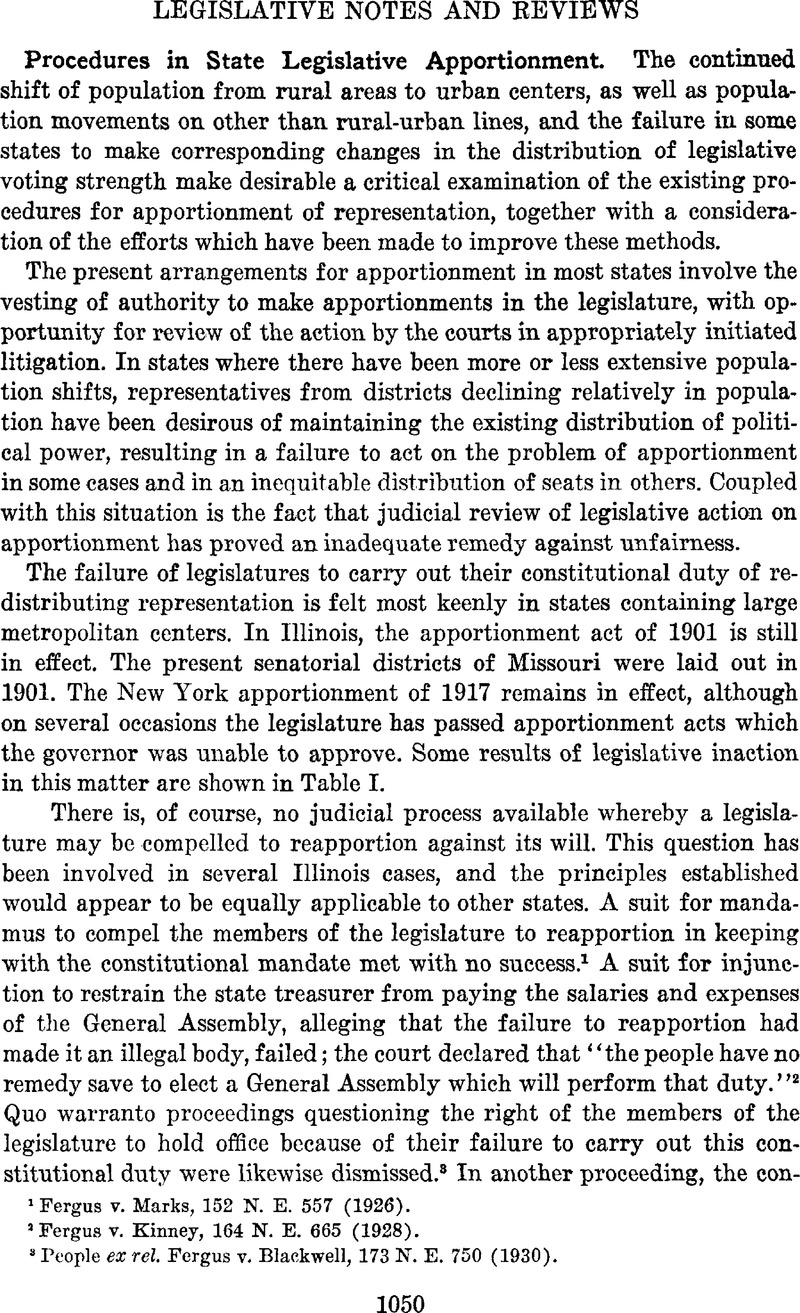No CrossRef data available.
Published online by Cambridge University Press: 02 September 2013

1 Fergus v. Marks, 152 N. E. 557 (1926).
2 Fergus v. Kinney, 164 N. E. 665 (1928).
3 People ex rel. Fergus v. Blackwell, 173 N. E. 750 (1930).
4 People v. Claridy, 165 N. E. 638 (1929).
5 Keogh v. Neely, 50 F. (2d) 685 (1931). The Supreme Court allowed this decision to stand in a decision (as yet unreported) handed down on May 16, 1932.
6 Brooks v. State, 70 N. E. 980 (Ind., 1904).
7 Ragland v. Anderson, 100 S. W. 865 (Ky., 1907).
8 People v. Rice, 31 N. E. 921 (1892). Reference to Table II shows the strength of this “compulsion” in throwing this decision out of line with judicial opinion in other cases.
9 For a discussion of the leading cases, see Reinsch, P. S., American Legislatures and Legislative Methods (1907), 204–212Google Scholar.
10 A proposed constitutional amendment to allow one representative for each 3,000 votes or major fraction thereof was defeated at the polls in 1930.
11 Constitution of Arizona, Art. IV, pt. 2, sec. 1.
12 Constitution of Idaho, Art. III; Compiled Statutes, 1919, p. 37.
13 See Aumann, F. B., “‘Rotten Borough’ Representation in Ohio,” 20 National Municipal Review, 82–86 (1931)CrossRefGoogle Scholar.
14 Art. IV, sec. 7.
15 State ex rel. Barrett v. Hitchcock, 146 S. W. 40 (1912).
16 State ex rel. Lashly v. Becker, 235 S. W. 1017 (1921). Doubt has been expressed as to whether this decision would be followed in the future, in view of the fact that the court divided on a strictly partisan basis in reaching its four-to-three division, and the further fact that in previous decisions the continued validity of the apportionment clauses had not been questioned despite the adoption of the initiative and referendum amendment. Short, L. M., “Congressional Redistricting in Missouri,” in this REVIEW, Aug., 1931Google Scholar.
17 Art. III, sec. 5.
18 Statutes of California, 1927, p. lxxxv.
19 Proposed Constitution of Illinois, 1922, Sec. 24.
20 Art. VII, sec. 3.
21 The apportioning agency should not include the governor or other officials not amenable to mandamus because of their position.
22 State ex rel. Barrett v. Hitchcock, 146 S. W. 40 (1912). In Commissioners v. Jewett, 110 N. E. 553 (1915), the supreme court of Indiana held in a suit for injunction to restrain the county board from dividing the county into legislative districts that the exercise of such legislative power “is deemed as free from judicial control as though it were attempted by the legislature itself.” Mandamus issued against local apportionment commissioners in Massachusetts in Attorney-General v. Suffolk County Apportionment Commissioners, 113 N. E. 581 (1916), but it appears that this remedy was specifically provided by law in this instance. However, mandamus was granted in New York against the local supervisors commanding them to divide the county into assembly districts. Baird v. Supervisors of the County of Kings, 33 N. E. 827 (1893).
23 It would be impossible to substitute rule for discretion as completely as has been done in the act providing for apportionment of the membership of the national House of Representatives among the states.
24 See The Michigan Plan, Report of a Survey by Special Committee of Wayne County Board of Supervisors (Detroit, 1931). This report contains, in addition to the recommendations of the committee with reference to Michigan, the constitutional provisions of all of the states relating to the subject of legislative structure and apportionment.
25 See Sess. Laws, 1931, c. 2; Pierce's Code, Arts. 3558, 3566 (1929); Hastings, Fred W., “Voters Initiate Reapportionment,” State Government, February, 1931, p. 7Google Scholar.
26 State ex rel. Miller v. Hinkle, 286 Pacific 839 (1930).
27 The use of the initiative to place a senatorial reapportionment in the constitution was blocked in Missouri, principally on the ground that such a matter was a “mere legislative act” and had no place in the “organic and permanent law of the state.” State ex rel. Halliburton v. Roach, 130 S. W. 689 (1910).
Comments
No Comments have been published for this article.